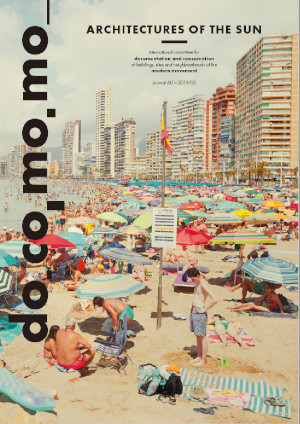PUBLICATIONS
DOCOMOMO JOURNAL 60: Architectures of the Sun

Author: Ana Tostões, Susana Lobo, Hannah Lewi, et. al.
Publisher: DOCOMOMO International, Lisboa, Portugal (2019)
Dimensions (length x width x height): 21 cm × 1 cm × 30 cm
Pages: 100
Language: English
go to DOCOMOMO International bookshop
DESCRIPTION:
Docomomo Journal 60 (2019/2)
EDITORIAL
The right to holidays or the emergence of an era of optimism
in memory of Tiago Freitas (1977—2017)
Entitled “Architectures of the Sun” this issue of the docomomo Journal is devoted to the theme of holidays, and considers the key role of Modern Movement architecture in the symbolic and functional affirmation of the new leisure era. The aim is to reflect on the transformation of the territory and to address the architectural challenges arising from the collective happiness and joy contained in what has been called the right to holidays.
In 1937, CIAM 5 specifically linked the housing question to leisure, considering it an absolute necessity to acknowledge that “the most privileged places will be chosen for the location of these [leisure] areas. Taking possession of these places by large masses will allow for rest and outdoor exercise, the indispensable recuperation of the forces lost in the city”.
As Charlotte Périand (1903–1999) asserted, the need to create machines à recréer, the goal was definitively to assure “the happiness of men”.
From the first optimistic architectural swimming-pool complexes to discovering the enjoyment of beaches or of winter sports in the mountains, these “architectures of the Sun” began to link the power of landscapes with the relaxation and pleasure of the human body. Associated with healthy living and claimed for all, for the first time, the beaches, mountains, lakes and forests became identified as places for vacations.
This docomomo Journal is a first attempt to discuss, among our network, the heritage of architectural programmes in the context of holidays, tourism and leisure, envisaged as a social conquest of modernity. Issues such as landscape, memory, identity and heritage, are explored against a background of territorial transformation and exploding tourism within the scope of the welfare society. From the joyful phenomenon of swimming pools in Australia to children’s beach-sports facilities under Italian fascism; or the workers’ vacation cities for trade unions, from republican Spain to the Franco period; from the creation of the seaside hotel to large scale tourist complexes in the snow or at seaside locations in Brazil, France, Greece, Portugal or Slovakia; all these reveal a wide range of perceptions of the landscape based on a singular modernity. The relationship between architecture and the tourist landscape was approached as a unique issue, experienced as a reshaping of leisure spaces in accordance with the needs of contemporary society.
Above all, the landscape became an inspiration for modern architecture and to a certain extent, for large-scale complexes, in claiming the right to vacation for all. To the middle class, it represented the opening up of something that, before the war, had been a privilege reserved for the elite.
docomomo International is grateful to Susana Lobo for accepting the challenge to be guest editor of this DJ. Thanks to her commitment, allied with meticulous and rigorous work, and to the skill of a wide range of professionals, scholars and researchers who have contributed with their knowledge and dedicated work, it is with great pleasure that we present this journal.
A variety of reflections is presented: from essays dedicated to the swimming phenomena and the creation of swimming-pool complexes, to the holiday colonies and cities created for workers’ relaxation, from an investigation of hotel typology, to essays on tourist megastructures and emblematic mountain resorts.
I also wish to thank Wilfried Wang for the exciting E.1027 Dossier, which reveals the most recent thinking on Eileen Gray (1878–1976) and Jean Badovici’s (1893–1956) unique and exquisite legacy. The Maison en bord de mer symbolically represents the vacation refuge, set within an amazing and poetic landscape, and also raises the question of the legacy of holiday architecture: the preservation, maintenance and re-use of these buildings and sites in accordance with a responsible evaluation of the landscape in environmental and sustainable terms.
EDITORIAL
The right to holidays or the emergence of an era of optimism
BY ANA TOSTÕES
INTRODUCTION
From paid holidays to mass tourism: a typological evolution
BY SUSANA LOBO
ESSAYS
Public swimming pools in Australia
BY HANNAH LEWI
Holiday colonies for Italian youth during Fascism
BY MARCO MULAZZANI
From the Ciutat de Repòs to the Ciudades Sindicales de Vacaciones: seaside Vacation City for Workers in Marbella. The present of modern leisure heritage
BY MAR LOREN-MÉNDEZ, DANIEL PINZÓN-AYALA AND ROBERTO F. ALONSO-J IMÉNEZ
Weaving the Xenia network in post-war Greece: The ethical structure of hospitality
BY EMILIA ATHANASSIOU
Hotel megastructures: the Balaia “turn key” experience in Portugal
BY SUSANA LOBO
Tourist towns in Languedoc-Roussillon: projects and discourse for mass tourism
BY IZOL MAREZ LOPÉZ
Building High Tatras: dilemma of form Architecture of 1960s and 1970s in the most famous Slovak mountain resort
BY HENRIETA MORAVCIKOVÁ
E.1027 DOSSIER
E.1027: Maison en bord de mer a prototypical vacation residence
BY WILFRIED WANG
E.1027: murder and mystery of the camera Gems on the history of the house E.1027 created by Eileen Gray and Jean Badovici
BY CHRISTIAN MÜLLER
Eileen Gray and the influence of Cubism
BY ROSAMUND DIAMOND
Should Le Corbusier’s E.1027 murals be considered as “historical monuments”?
BY AGNÈS CAILLIAU
NEWS
DOCUMENTATION ISSUE
Tourism and modern architecture in a “Green Hell”: Hotel Amazonas (1947–1952)
BY RICARDO PAIVA
BOOK REVIEWS
APPENDIX
Source: www.docomomo.com



